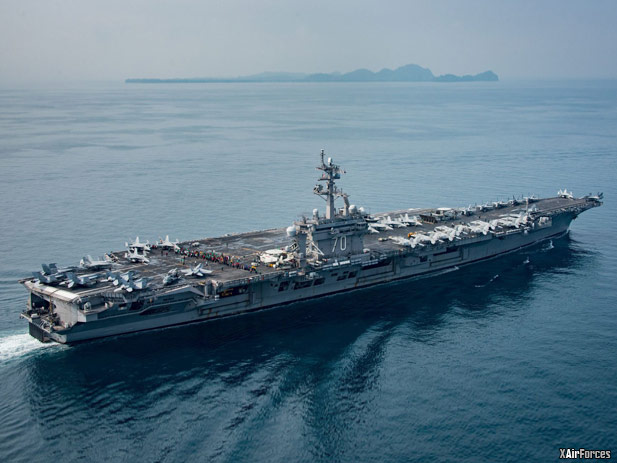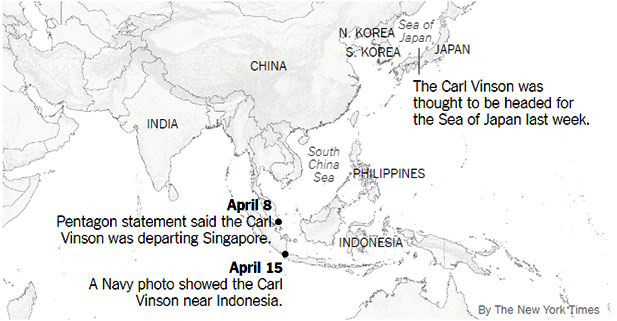
U.S. Aircraft Carrier Wasn’t Sailing to Deter North Korea, as U.S. Suggested

Just over a week ago, the White House declared that ordering an American aircraft carrier into the Sea of Japan would send a powerful deterrent signal to North Korea and give President Trump more options in responding to the North’s provocative behavior. “We’re sending an armada,” Mr. Trump said to Fox News last Tuesday afternoon.
The problem was that the carrier, the Carl Vinson, and the three other warships in its strike force were that very moment sailing in the opposite direction, to take part in joint exercises with the Australian Navy in the Indian Ocean, 3,500 miles southwest of the Korean Peninsula.
White House officials said Tuesday that they had been relying on guidance from the Defense Department. Officials there described a glitch-ridden sequence of events, from an ill-timed announcement of the deployment by the military’s Pacific Command to a partially erroneous explanation by the defense secretary, Jim Mattis — all of which perpetuated the false narrative that a flotilla was racing toward the waters off North Korea.
By the time the White House was asked about the Carl Vinson, its imminent arrival had been emblazoned on front pages across East Asia, fanning fears that Mr. Trump was considering a pre-emptive military strike. It was portrayed as further evidence of the president’s muscular style days after he ordered a missile strike on Syria that came while he and President Xi Jinping of China chatted over dessert during a meeting in Florida.
With Mr. Trump himself playing up the show of force, Pentagon officials said, rolling back the story became difficult.
The story of the wayward carrier might never have come to light had the Navy not posted a photo online Monday of the Carl Vinson sailing south through the Sunda Strait, which separates the Indonesian islands of Java and Sumatra. It was taken on Saturday, four days after the White House press secretary, Sean Spicer, described its mission in the Sea of Japan.
Now, the Carl Vinson is finally on a course for the Korean Peninsula, expected to arrive in the region next week, according to Defense Department officials. White House officials declined to comment on the confusion, referring questions to the Pentagon. “Sean discussed it once when asked, and it was all about process,” a spokesman, Michael Short, said of Mr. Spicer.
Privately, however, other officials expressed bewilderment that the Pentagon did not correct its timeline, particularly given the tensions in the region and the fact that Mr. Spicer, as well as the national security adviser, Lt. Gen. H. R. McMaster, were publicly answering questions about it.

“The ship is now moving north to the Western Pacific,” the Pentagon’s chief spokeswoman, Dana White, said Tuesday. “This should have been communicated more clearly at the time.”
The miscues began on April 9 when the public affairs office of the Navy’s Third Fleet issued a news release saying that Adm. Harry B. Harris Jr., the Pacific commander, had ordered the Carl Vinson, a Nimitz-class nuclear-powered carrier, and its strike force — two destroyers and one cruiser — to leave Singapore and sail to the Western Pacific. As is customary, the Navy did not say exactly where the carrier force was headed or its precise mission.
Given the timing, it hardly needed to: Mr. Trump had just wrapped up a two-day summit meeting with Mr. Xi at his Palm Beach club, Mar-a-Lago, with a message that the United States had run out of patience with North Korea’s dictator, Kim Jong-un, and its nuclear and missile programs.
That Sunday, General McMaster told Fox News that the deployment was a “prudent” move, designed to give the president “a full range of options to remove” the threat posed by Mr. Kim.
What the Navy did not say was that the Carl Vinson had to carry out another mission before it set sail north: a long-scheduled joint exercise with the Australian Navy in the Indian Ocean.
South Korean and Japanese news media, as well as The New York Times, reported Admiral Harris’s order as evidence that the crisis was intensifying. While an aircraft carrier is not the weapon of choice for a strike on North Korea — such an operation would more likely involve long-range bombers and cruise missiles — it sends a vivid message of military might.
In July 2010, President Barack Obama ordered the aircraft carrier George Washington to the Sea of Japan to intimidate the North after it had torpedoed a South Korean Navy corvette, killing 46 sailors. When his defense secretary, Robert M. Gates, asked him to reroute the carrier to the Yellow Sea, to send an additional message to Beijing, Mr. Obama resisted.
“I don’t call audibles with aircraft carriers,” he said, using a football metaphor to reject the midcourse correction.
By all accounts, Mr. Trump is less worried than Mr. Obama about making such calls on the fly. His aides have praised this unpredictability as a virtue in dealing with rogue leaders in North Korea and Syria.
In South Korea, though, fears of a full-blown war erupted. The government rushed to reassure the public that the Carl Vinson was coming only to deter North Korean provocations. April 15 is the birthday of Kim Il-sung, the nation’s founder and the grandfather of Kim Jong-un — an occasion the North typically uses to conduct celebratory weapons tests.
On April 11, Mr. Trump stoked the fears of military action with an early-morning Twitter post: “North Korea is looking for trouble. If China decides to help, that would be great. If not, we will solve the problem without them! U.S.A.” Later that day, Mr. Spicer was asked by a reporter, who assumed the Carl Vinson was on its way north, why the United States had decided to dispatch the carrier group to the Sea of Japan.
“A carrier group is several things,” Mr. Spicer replied. “The forward deployment is deterrence, presence.” He added, “I think when you see a carrier group steaming into an area like that, the forward presence of that is clearly, through almost every instance, a huge deterrence.”
Mr. Spicer did not point out that the Carl Vinson was not, in fact, steaming into the area and would not be for 14 more days. A senior administration official said the press secretary was using talking points supplied by the Pentagon. He was discussing the rationale for sending a carrier, this official said, not confirming the ship’s schedule.
An hour after Mr. Spicer left the podium, Mr. Mattis, the defense secretary, reinforced the perception of ships racing to the scene. Speaking at the Pentagon, he said the Navy disclosed the Carl Vinson’s itinerary in advance because the exercise with the Australians had been canceled. “We had to explain why she wasn’t in that exercise,” he said.
Mr. Mattis, however, had conflated two things: Admiral Harris had canceled only a port call for the Carl Vinson in Fremantle, Australia, according to Pentagon officials, because he feared that images of sailors on shore leave would be unseemly at a time when North Korea was firing missiles.
Navy officials said Admiral Harris never meant to suggest he was canceling the naval exercise. Organizing such exercises is a complicated effort that takes months. One official described it as a high-end exercise, raising the possibility that the two navies practiced scenarios to counter China, or tested new missile defenses or cyberoperations.
Some officials expressed irritation with Admiral Harris, saying he did not think through the consequences of announcing the deployment of an aircraft carrier during a period of high tension.
Mr. Mattis sent mixed signals about the mission. He stressed the need for the Navy to operate freely in the Pacific but added, “There’s not a specific demand signal or specific reason why we’re sending her up there.”
After a week of war drums, fueled by the reports of the oncoming armada, tensions subsided when the weekend passed with only a military parade in Pyongyang and a failed missile test.
Then, on Monday, the Navy posted the photo of the Carl Vinson, bristling with fighter jets as it passed Indonesia. It was spotted by Defense News, a trade publication, which broke the news that the ship was thousands of miles from where most of the world thought it was.
Helene Cooper contributed reporting from Riyadh, Saudi Arabia.
Source: Washington - By MARK LANDLER and ERIC SCHMITT - www.nytimes.com - 18 April 2017
Photo: The Navy posted a photo of the U.S.S. Carl Vinson sailing Saturday in the Sunda Strait off the coast of Indonesia, thousands of miles southwest of the Korean Peninsula. (Photo by Credit MC2 Sean M. Castellano/Agence France-Presse — Getty Images)
(18.04.2017)
|